AERO 2486: Aircraft Maintenance Management - Aloha Airlines Case Study
VerifiedAdded on 2023/04/24
|8
|2003
|317
Case Study
AI Summary
This case study examines the Aloha Airlines Flight 243 incident, where an explosive decompression occurred on a Boeing 737-200. The study delves into the human factors contributing to the accident, including excessive workload, stress, and inadequate training of maintenance staff. It analyzes the airline's compliance with regulatory and manufacturer recommendations, highlighting shortcomings in the aircraft's design and maintenance procedures. The study also evaluates the AA maintenance program, identifying issues such as inadequate inspection intervals and failure to identify fatigue cracks. The analysis emphasizes the importance of improved aircraft design, rigorous maintenance practices, and adherence to FAA regulations to prevent similar aviation disasters. The study underscores the impact of human error, the effectiveness of maintenance programs, and the role of regulatory oversight in ensuring aviation safety. The accident highlighted critical failures in identifying and addressing fatigue cracks, and the importance of comprehensive inspections and adherence to safety protocols.
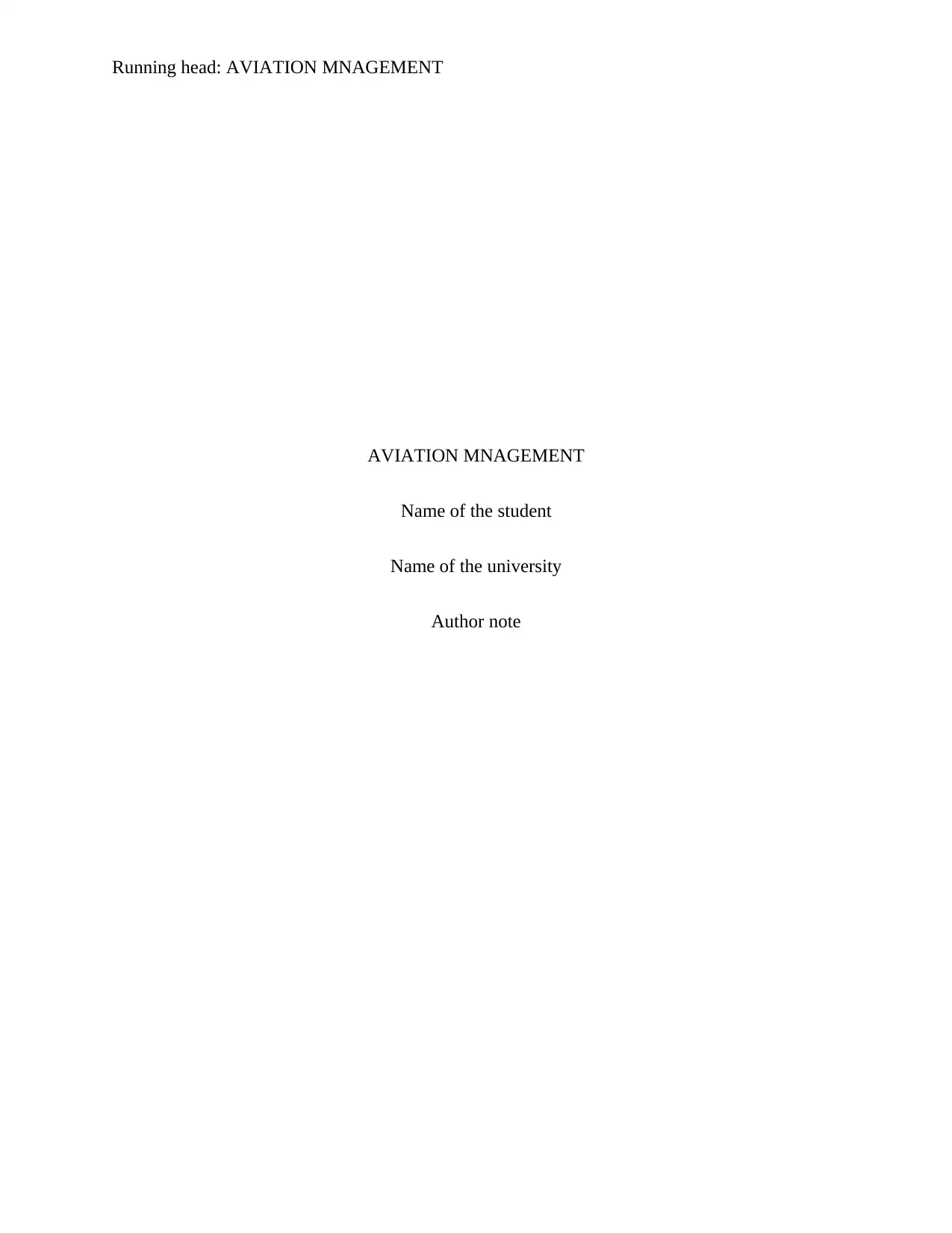
Running head: AVIATION MNAGEMENT
AVIATION MNAGEMENT
Name of the student
Name of the university
Author note
AVIATION MNAGEMENT
Name of the student
Name of the university
Author note
Paraphrase This Document
Need a fresh take? Get an instant paraphrase of this document with our AI Paraphraser
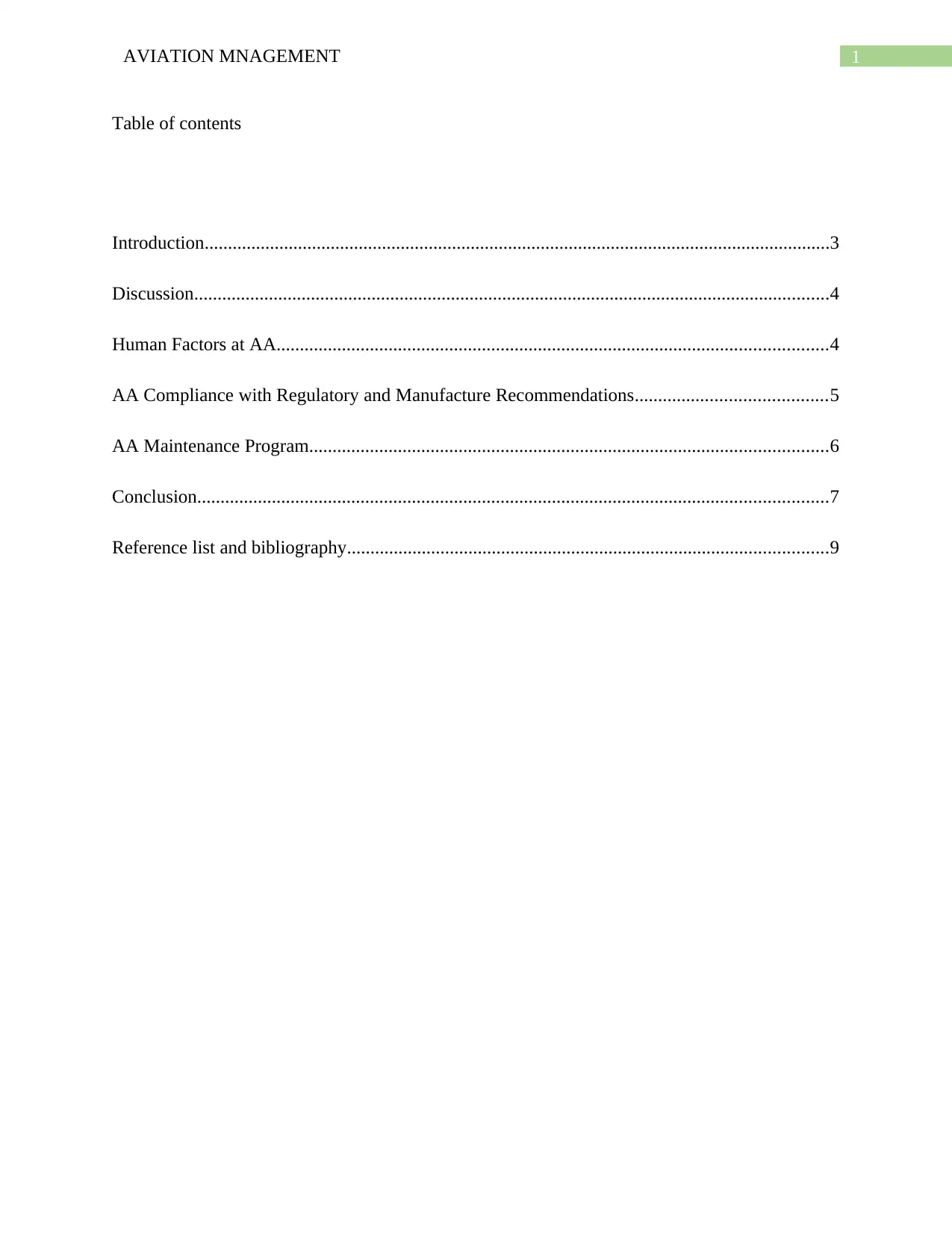
1AVIATION MNAGEMENT
Table of contents
Introduction......................................................................................................................................3
Discussion........................................................................................................................................4
Human Factors at AA......................................................................................................................4
AA Compliance with Regulatory and Manufacture Recommendations.........................................5
AA Maintenance Program...............................................................................................................6
Conclusion.......................................................................................................................................7
Reference list and bibliography.......................................................................................................9
Table of contents
Introduction......................................................................................................................................3
Discussion........................................................................................................................................4
Human Factors at AA......................................................................................................................4
AA Compliance with Regulatory and Manufacture Recommendations.........................................5
AA Maintenance Program...............................................................................................................6
Conclusion.......................................................................................................................................7
Reference list and bibliography.......................................................................................................9
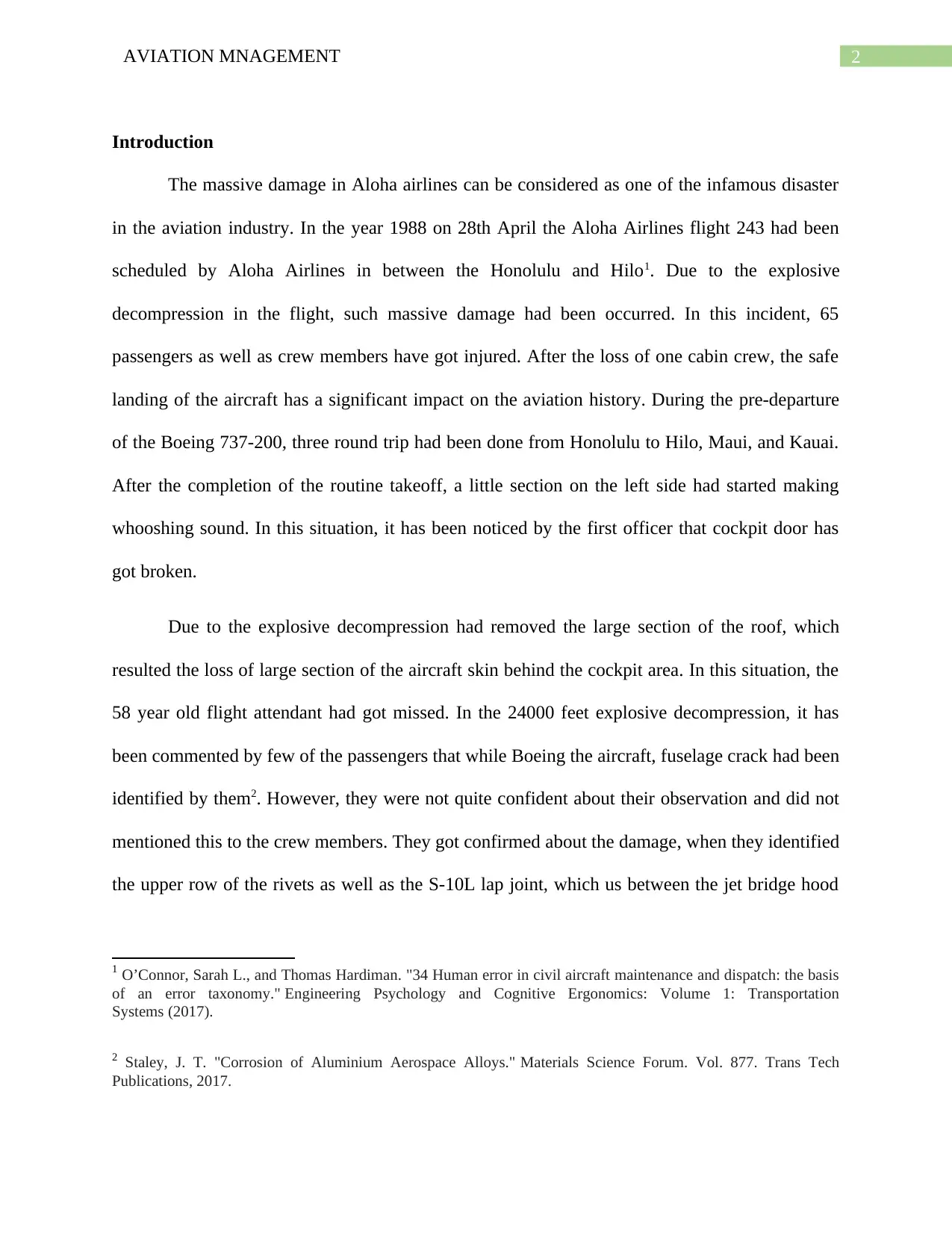
2AVIATION MNAGEMENT
Introduction
The massive damage in Aloha airlines can be considered as one of the infamous disaster
in the aviation industry. In the year 1988 on 28th April the Aloha Airlines flight 243 had been
scheduled by Aloha Airlines in between the Honolulu and Hilo1. Due to the explosive
decompression in the flight, such massive damage had been occurred. In this incident, 65
passengers as well as crew members have got injured. After the loss of one cabin crew, the safe
landing of the aircraft has a significant impact on the aviation history. During the pre-departure
of the Boeing 737-200, three round trip had been done from Honolulu to Hilo, Maui, and Kauai.
After the completion of the routine takeoff, a little section on the left side had started making
whooshing sound. In this situation, it has been noticed by the first officer that cockpit door has
got broken.
Due to the explosive decompression had removed the large section of the roof, which
resulted the loss of large section of the aircraft skin behind the cockpit area. In this situation, the
58 year old flight attendant had got missed. In the 24000 feet explosive decompression, it has
been commented by few of the passengers that while Boeing the aircraft, fuselage crack had been
identified by them2. However, they were not quite confident about their observation and did not
mentioned this to the crew members. They got confirmed about the damage, when they identified
the upper row of the rivets as well as the S-10L lap joint, which us between the jet bridge hood
1 O’Connor, Sarah L., and Thomas Hardiman. "34 Human error in civil aircraft maintenance and dispatch: the basis
of an error taxonomy." Engineering Psychology and Cognitive Ergonomics: Volume 1: Transportation
Systems (2017).
2 Staley, J. T. "Corrosion of Aluminium Aerospace Alloys." Materials Science Forum. Vol. 877. Trans Tech
Publications, 2017.
Introduction
The massive damage in Aloha airlines can be considered as one of the infamous disaster
in the aviation industry. In the year 1988 on 28th April the Aloha Airlines flight 243 had been
scheduled by Aloha Airlines in between the Honolulu and Hilo1. Due to the explosive
decompression in the flight, such massive damage had been occurred. In this incident, 65
passengers as well as crew members have got injured. After the loss of one cabin crew, the safe
landing of the aircraft has a significant impact on the aviation history. During the pre-departure
of the Boeing 737-200, three round trip had been done from Honolulu to Hilo, Maui, and Kauai.
After the completion of the routine takeoff, a little section on the left side had started making
whooshing sound. In this situation, it has been noticed by the first officer that cockpit door has
got broken.
Due to the explosive decompression had removed the large section of the roof, which
resulted the loss of large section of the aircraft skin behind the cockpit area. In this situation, the
58 year old flight attendant had got missed. In the 24000 feet explosive decompression, it has
been commented by few of the passengers that while Boeing the aircraft, fuselage crack had been
identified by them2. However, they were not quite confident about their observation and did not
mentioned this to the crew members. They got confirmed about the damage, when they identified
the upper row of the rivets as well as the S-10L lap joint, which us between the jet bridge hood
1 O’Connor, Sarah L., and Thomas Hardiman. "34 Human error in civil aircraft maintenance and dispatch: the basis
of an error taxonomy." Engineering Psychology and Cognitive Ergonomics: Volume 1: Transportation
Systems (2017).
2 Staley, J. T. "Corrosion of Aluminium Aerospace Alloys." Materials Science Forum. Vol. 877. Trans Tech
Publications, 2017.
⊘ This is a preview!⊘
Do you want full access?
Subscribe today to unlock all pages.

Trusted by 1+ million students worldwide
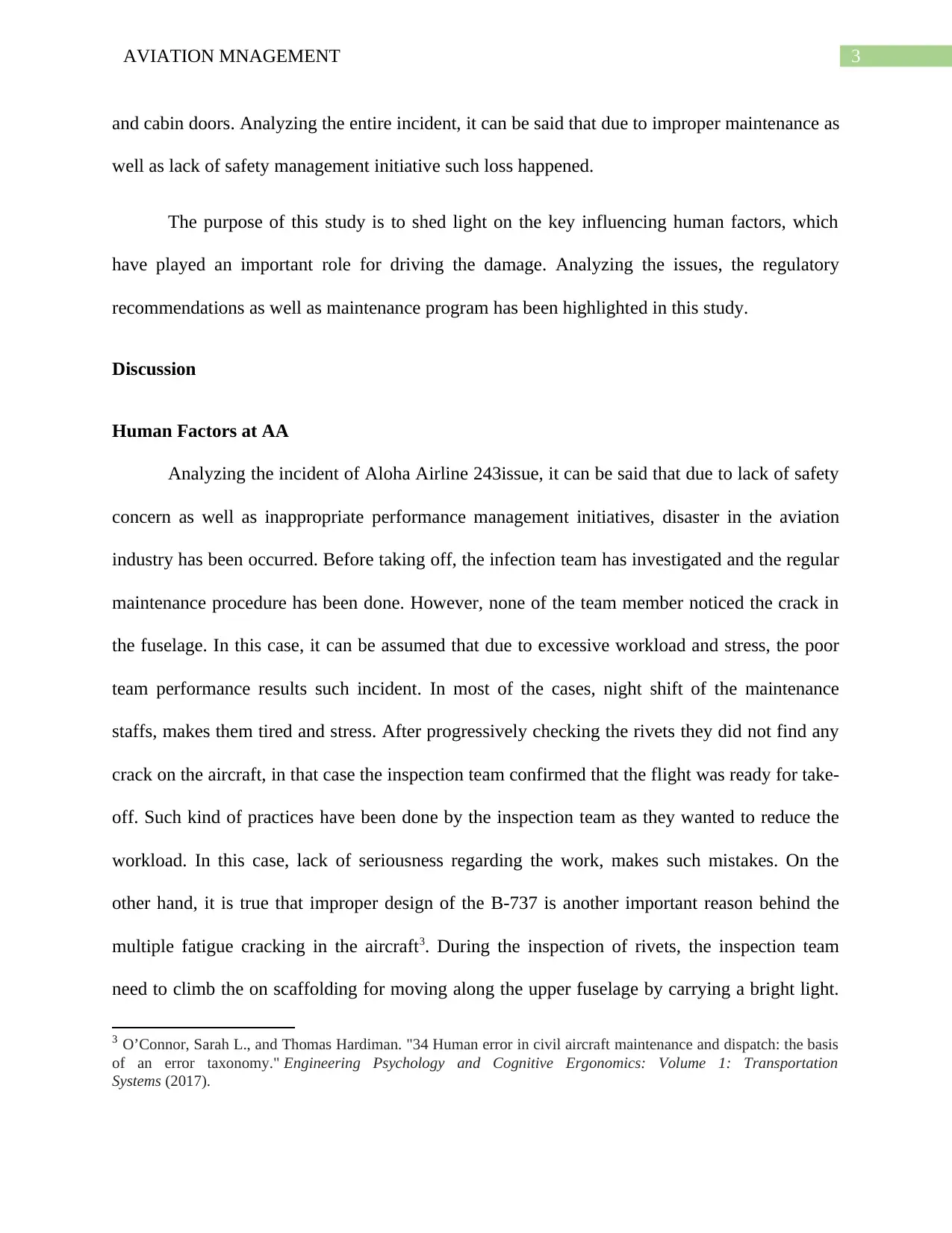
3AVIATION MNAGEMENT
and cabin doors. Analyzing the entire incident, it can be said that due to improper maintenance as
well as lack of safety management initiative such loss happened.
The purpose of this study is to shed light on the key influencing human factors, which
have played an important role for driving the damage. Analyzing the issues, the regulatory
recommendations as well as maintenance program has been highlighted in this study.
Discussion
Human Factors at AA
Analyzing the incident of Aloha Airline 243issue, it can be said that due to lack of safety
concern as well as inappropriate performance management initiatives, disaster in the aviation
industry has been occurred. Before taking off, the infection team has investigated and the regular
maintenance procedure has been done. However, none of the team member noticed the crack in
the fuselage. In this case, it can be assumed that due to excessive workload and stress, the poor
team performance results such incident. In most of the cases, night shift of the maintenance
staffs, makes them tired and stress. After progressively checking the rivets they did not find any
crack on the aircraft, in that case the inspection team confirmed that the flight was ready for take-
off. Such kind of practices have been done by the inspection team as they wanted to reduce the
workload. In this case, lack of seriousness regarding the work, makes such mistakes. On the
other hand, it is true that improper design of the B-737 is another important reason behind the
multiple fatigue cracking in the aircraft3. During the inspection of rivets, the inspection team
need to climb the on scaffolding for moving along the upper fuselage by carrying a bright light.
3 O’Connor, Sarah L., and Thomas Hardiman. "34 Human error in civil aircraft maintenance and dispatch: the basis
of an error taxonomy." Engineering Psychology and Cognitive Ergonomics: Volume 1: Transportation
Systems (2017).
and cabin doors. Analyzing the entire incident, it can be said that due to improper maintenance as
well as lack of safety management initiative such loss happened.
The purpose of this study is to shed light on the key influencing human factors, which
have played an important role for driving the damage. Analyzing the issues, the regulatory
recommendations as well as maintenance program has been highlighted in this study.
Discussion
Human Factors at AA
Analyzing the incident of Aloha Airline 243issue, it can be said that due to lack of safety
concern as well as inappropriate performance management initiatives, disaster in the aviation
industry has been occurred. Before taking off, the infection team has investigated and the regular
maintenance procedure has been done. However, none of the team member noticed the crack in
the fuselage. In this case, it can be assumed that due to excessive workload and stress, the poor
team performance results such incident. In most of the cases, night shift of the maintenance
staffs, makes them tired and stress. After progressively checking the rivets they did not find any
crack on the aircraft, in that case the inspection team confirmed that the flight was ready for take-
off. Such kind of practices have been done by the inspection team as they wanted to reduce the
workload. In this case, lack of seriousness regarding the work, makes such mistakes. On the
other hand, it is true that improper design of the B-737 is another important reason behind the
multiple fatigue cracking in the aircraft3. During the inspection of rivets, the inspection team
need to climb the on scaffolding for moving along the upper fuselage by carrying a bright light.
3 O’Connor, Sarah L., and Thomas Hardiman. "34 Human error in civil aircraft maintenance and dispatch: the basis
of an error taxonomy." Engineering Psychology and Cognitive Ergonomics: Volume 1: Transportation
Systems (2017).
Paraphrase This Document
Need a fresh take? Get an instant paraphrase of this document with our AI Paraphraser
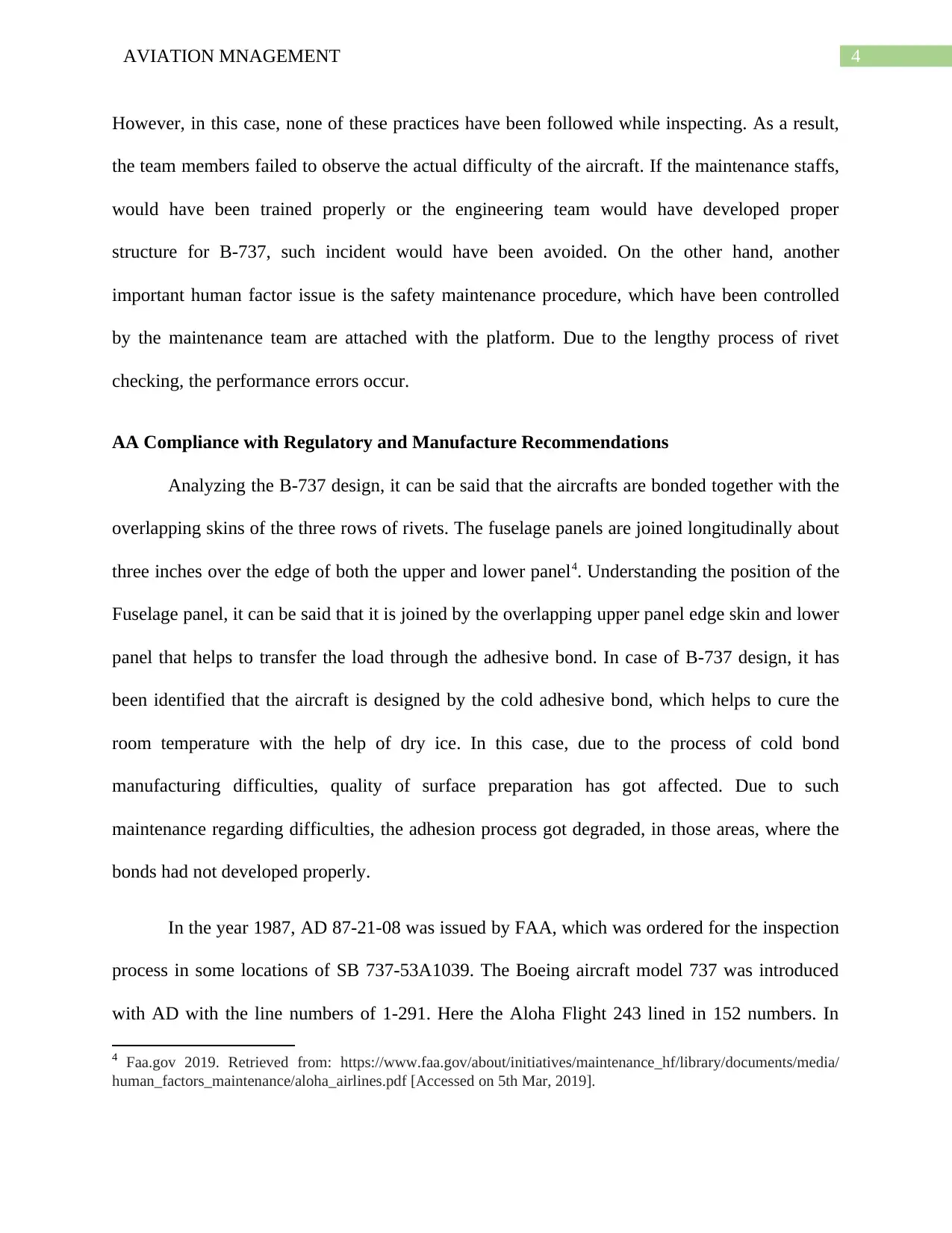
4AVIATION MNAGEMENT
However, in this case, none of these practices have been followed while inspecting. As a result,
the team members failed to observe the actual difficulty of the aircraft. If the maintenance staffs,
would have been trained properly or the engineering team would have developed proper
structure for B-737, such incident would have been avoided. On the other hand, another
important human factor issue is the safety maintenance procedure, which have been controlled
by the maintenance team are attached with the platform. Due to the lengthy process of rivet
checking, the performance errors occur.
AA Compliance with Regulatory and Manufacture Recommendations
Analyzing the B-737 design, it can be said that the aircrafts are bonded together with the
overlapping skins of the three rows of rivets. The fuselage panels are joined longitudinally about
three inches over the edge of both the upper and lower panel4. Understanding the position of the
Fuselage panel, it can be said that it is joined by the overlapping upper panel edge skin and lower
panel that helps to transfer the load through the adhesive bond. In case of B-737 design, it has
been identified that the aircraft is designed by the cold adhesive bond, which helps to cure the
room temperature with the help of dry ice. In this case, due to the process of cold bond
manufacturing difficulties, quality of surface preparation has got affected. Due to such
maintenance regarding difficulties, the adhesion process got degraded, in those areas, where the
bonds had not developed properly.
In the year 1987, AD 87-21-08 was issued by FAA, which was ordered for the inspection
process in some locations of SB 737-53A1039. The Boeing aircraft model 737 was introduced
with AD with the line numbers of 1-291. Here the Aloha Flight 243 lined in 152 numbers. In
4 Faa.gov 2019. Retrieved from: https://www.faa.gov/about/initiatives/maintenance_hf/library/documents/media/
human_factors_maintenance/aloha_airlines.pdf [Accessed on 5th Mar, 2019].
However, in this case, none of these practices have been followed while inspecting. As a result,
the team members failed to observe the actual difficulty of the aircraft. If the maintenance staffs,
would have been trained properly or the engineering team would have developed proper
structure for B-737, such incident would have been avoided. On the other hand, another
important human factor issue is the safety maintenance procedure, which have been controlled
by the maintenance team are attached with the platform. Due to the lengthy process of rivet
checking, the performance errors occur.
AA Compliance with Regulatory and Manufacture Recommendations
Analyzing the B-737 design, it can be said that the aircrafts are bonded together with the
overlapping skins of the three rows of rivets. The fuselage panels are joined longitudinally about
three inches over the edge of both the upper and lower panel4. Understanding the position of the
Fuselage panel, it can be said that it is joined by the overlapping upper panel edge skin and lower
panel that helps to transfer the load through the adhesive bond. In case of B-737 design, it has
been identified that the aircraft is designed by the cold adhesive bond, which helps to cure the
room temperature with the help of dry ice. In this case, due to the process of cold bond
manufacturing difficulties, quality of surface preparation has got affected. Due to such
maintenance regarding difficulties, the adhesion process got degraded, in those areas, where the
bonds had not developed properly.
In the year 1987, AD 87-21-08 was issued by FAA, which was ordered for the inspection
process in some locations of SB 737-53A1039. The Boeing aircraft model 737 was introduced
with AD with the line numbers of 1-291. Here the Aloha Flight 243 lined in 152 numbers. In
4 Faa.gov 2019. Retrieved from: https://www.faa.gov/about/initiatives/maintenance_hf/library/documents/media/
human_factors_maintenance/aloha_airlines.pdf [Accessed on 5th Mar, 2019].
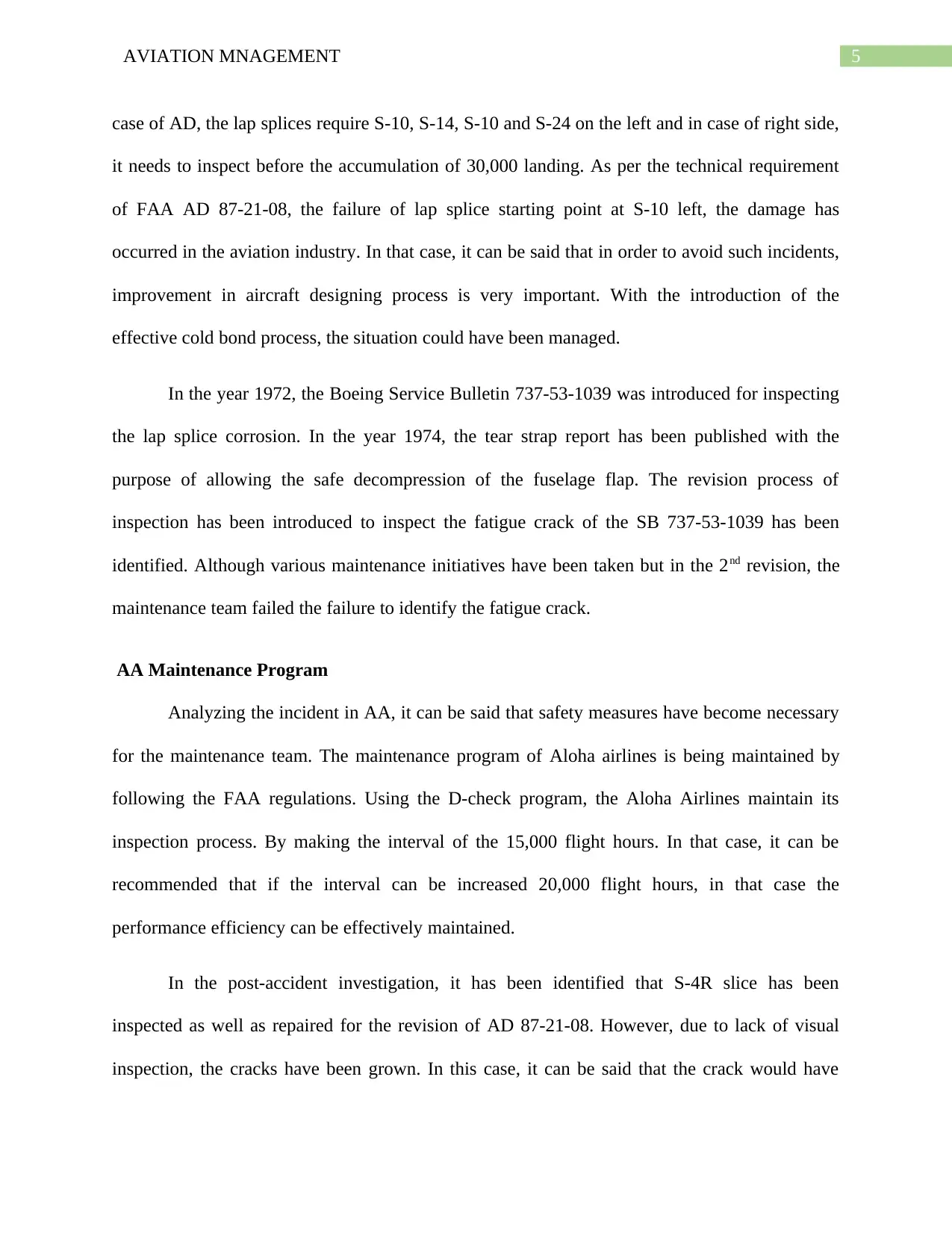
5AVIATION MNAGEMENT
case of AD, the lap splices require S-10, S-14, S-10 and S-24 on the left and in case of right side,
it needs to inspect before the accumulation of 30,000 landing. As per the technical requirement
of FAA AD 87-21-08, the failure of lap splice starting point at S-10 left, the damage has
occurred in the aviation industry. In that case, it can be said that in order to avoid such incidents,
improvement in aircraft designing process is very important. With the introduction of the
effective cold bond process, the situation could have been managed.
In the year 1972, the Boeing Service Bulletin 737-53-1039 was introduced for inspecting
the lap splice corrosion. In the year 1974, the tear strap report has been published with the
purpose of allowing the safe decompression of the fuselage flap. The revision process of
inspection has been introduced to inspect the fatigue crack of the SB 737-53-1039 has been
identified. Although various maintenance initiatives have been taken but in the 2nd revision, the
maintenance team failed the failure to identify the fatigue crack.
AA Maintenance Program
Analyzing the incident in AA, it can be said that safety measures have become necessary
for the maintenance team. The maintenance program of Aloha airlines is being maintained by
following the FAA regulations. Using the D-check program, the Aloha Airlines maintain its
inspection process. By making the interval of the 15,000 flight hours. In that case, it can be
recommended that if the interval can be increased 20,000 flight hours, in that case the
performance efficiency can be effectively maintained.
In the post-accident investigation, it has been identified that S-4R slice has been
inspected as well as repaired for the revision of AD 87-21-08. However, due to lack of visual
inspection, the cracks have been grown. In this case, it can be said that the crack would have
case of AD, the lap splices require S-10, S-14, S-10 and S-24 on the left and in case of right side,
it needs to inspect before the accumulation of 30,000 landing. As per the technical requirement
of FAA AD 87-21-08, the failure of lap splice starting point at S-10 left, the damage has
occurred in the aviation industry. In that case, it can be said that in order to avoid such incidents,
improvement in aircraft designing process is very important. With the introduction of the
effective cold bond process, the situation could have been managed.
In the year 1972, the Boeing Service Bulletin 737-53-1039 was introduced for inspecting
the lap splice corrosion. In the year 1974, the tear strap report has been published with the
purpose of allowing the safe decompression of the fuselage flap. The revision process of
inspection has been introduced to inspect the fatigue crack of the SB 737-53-1039 has been
identified. Although various maintenance initiatives have been taken but in the 2nd revision, the
maintenance team failed the failure to identify the fatigue crack.
AA Maintenance Program
Analyzing the incident in AA, it can be said that safety measures have become necessary
for the maintenance team. The maintenance program of Aloha airlines is being maintained by
following the FAA regulations. Using the D-check program, the Aloha Airlines maintain its
inspection process. By making the interval of the 15,000 flight hours. In that case, it can be
recommended that if the interval can be increased 20,000 flight hours, in that case the
performance efficiency can be effectively maintained.
In the post-accident investigation, it has been identified that S-4R slice has been
inspected as well as repaired for the revision of AD 87-21-08. However, due to lack of visual
inspection, the cracks have been grown. In this case, it can be said that the crack would have
⊘ This is a preview!⊘
Do you want full access?
Subscribe today to unlock all pages.

Trusted by 1+ million students worldwide
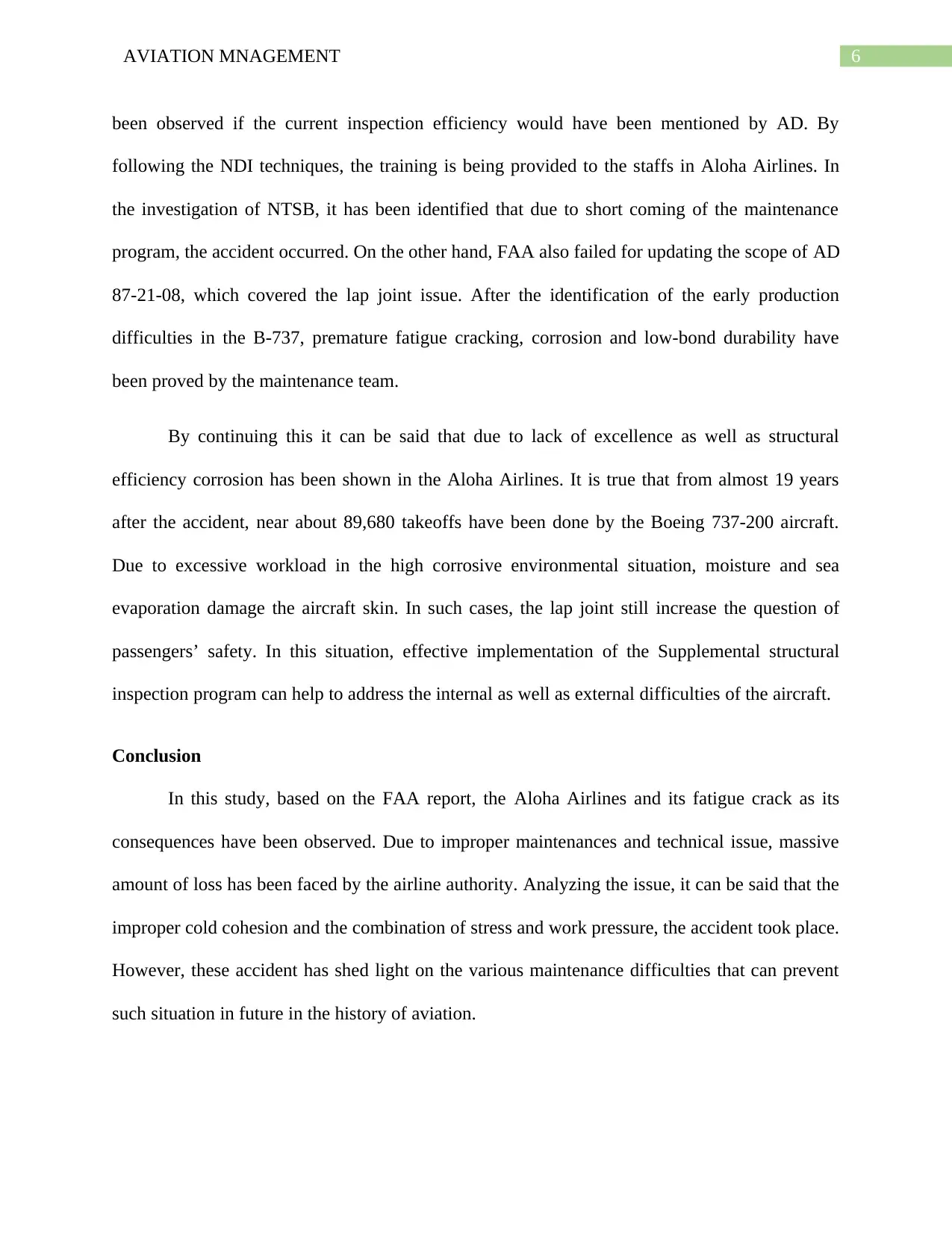
6AVIATION MNAGEMENT
been observed if the current inspection efficiency would have been mentioned by AD. By
following the NDI techniques, the training is being provided to the staffs in Aloha Airlines. In
the investigation of NTSB, it has been identified that due to short coming of the maintenance
program, the accident occurred. On the other hand, FAA also failed for updating the scope of AD
87-21-08, which covered the lap joint issue. After the identification of the early production
difficulties in the B-737, premature fatigue cracking, corrosion and low-bond durability have
been proved by the maintenance team.
By continuing this it can be said that due to lack of excellence as well as structural
efficiency corrosion has been shown in the Aloha Airlines. It is true that from almost 19 years
after the accident, near about 89,680 takeoffs have been done by the Boeing 737-200 aircraft.
Due to excessive workload in the high corrosive environmental situation, moisture and sea
evaporation damage the aircraft skin. In such cases, the lap joint still increase the question of
passengers’ safety. In this situation, effective implementation of the Supplemental structural
inspection program can help to address the internal as well as external difficulties of the aircraft.
Conclusion
In this study, based on the FAA report, the Aloha Airlines and its fatigue crack as its
consequences have been observed. Due to improper maintenances and technical issue, massive
amount of loss has been faced by the airline authority. Analyzing the issue, it can be said that the
improper cold cohesion and the combination of stress and work pressure, the accident took place.
However, these accident has shed light on the various maintenance difficulties that can prevent
such situation in future in the history of aviation.
been observed if the current inspection efficiency would have been mentioned by AD. By
following the NDI techniques, the training is being provided to the staffs in Aloha Airlines. In
the investigation of NTSB, it has been identified that due to short coming of the maintenance
program, the accident occurred. On the other hand, FAA also failed for updating the scope of AD
87-21-08, which covered the lap joint issue. After the identification of the early production
difficulties in the B-737, premature fatigue cracking, corrosion and low-bond durability have
been proved by the maintenance team.
By continuing this it can be said that due to lack of excellence as well as structural
efficiency corrosion has been shown in the Aloha Airlines. It is true that from almost 19 years
after the accident, near about 89,680 takeoffs have been done by the Boeing 737-200 aircraft.
Due to excessive workload in the high corrosive environmental situation, moisture and sea
evaporation damage the aircraft skin. In such cases, the lap joint still increase the question of
passengers’ safety. In this situation, effective implementation of the Supplemental structural
inspection program can help to address the internal as well as external difficulties of the aircraft.
Conclusion
In this study, based on the FAA report, the Aloha Airlines and its fatigue crack as its
consequences have been observed. Due to improper maintenances and technical issue, massive
amount of loss has been faced by the airline authority. Analyzing the issue, it can be said that the
improper cold cohesion and the combination of stress and work pressure, the accident took place.
However, these accident has shed light on the various maintenance difficulties that can prevent
such situation in future in the history of aviation.
Paraphrase This Document
Need a fresh take? Get an instant paraphrase of this document with our AI Paraphraser
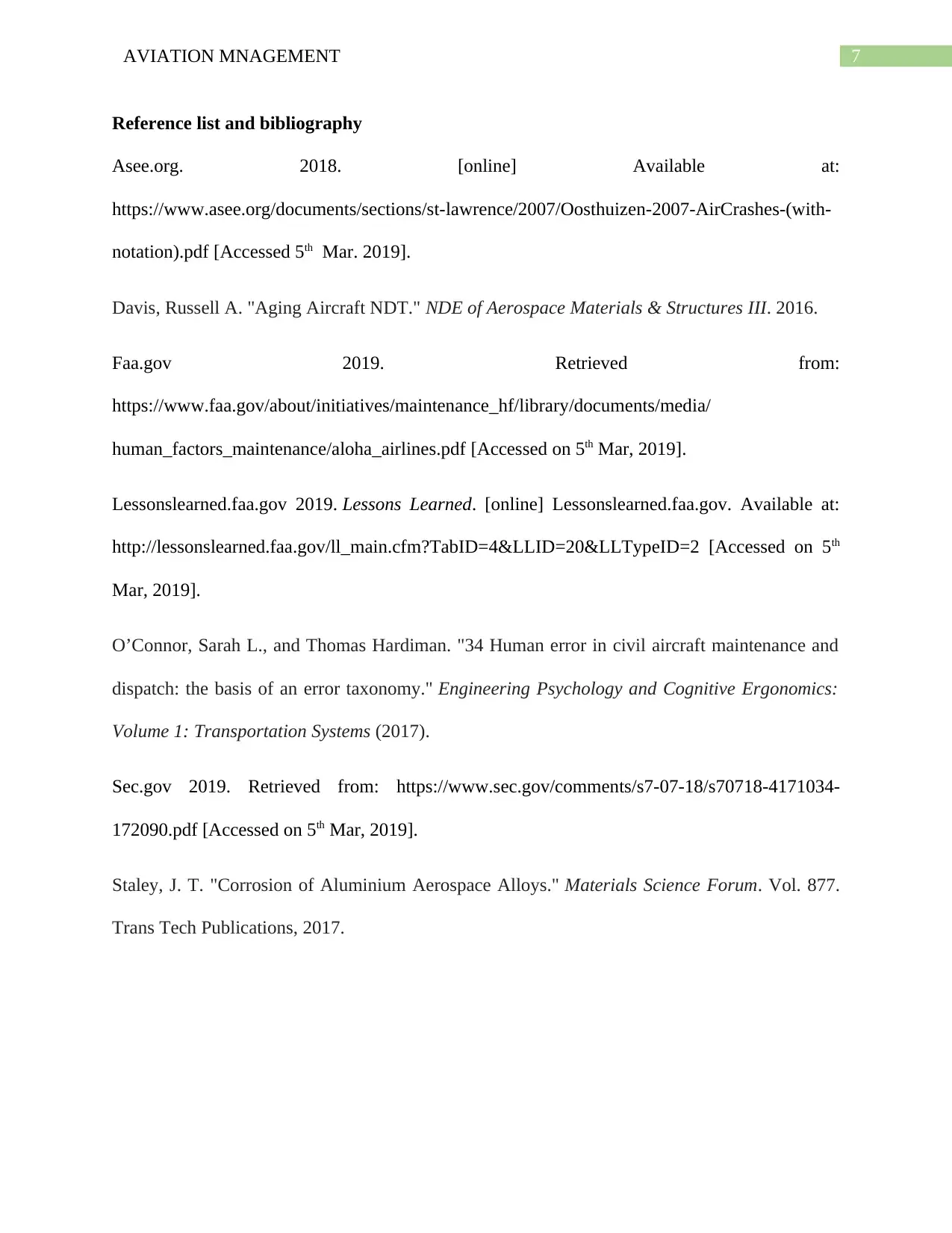
7AVIATION MNAGEMENT
Reference list and bibliography
Asee.org. 2018. [online] Available at:
https://www.asee.org/documents/sections/st-lawrence/2007/Oosthuizen-2007-AirCrashes-(with-
notation).pdf [Accessed 5th Mar. 2019].
Davis, Russell A. "Aging Aircraft NDT." NDE of Aerospace Materials & Structures III. 2016.
Faa.gov 2019. Retrieved from:
https://www.faa.gov/about/initiatives/maintenance_hf/library/documents/media/
human_factors_maintenance/aloha_airlines.pdf [Accessed on 5th Mar, 2019].
Lessonslearned.faa.gov 2019. Lessons Learned. [online] Lessonslearned.faa.gov. Available at:
http://lessonslearned.faa.gov/ll_main.cfm?TabID=4&LLID=20&LLTypeID=2 [Accessed on 5th
Mar, 2019].
O’Connor, Sarah L., and Thomas Hardiman. "34 Human error in civil aircraft maintenance and
dispatch: the basis of an error taxonomy." Engineering Psychology and Cognitive Ergonomics:
Volume 1: Transportation Systems (2017).
Sec.gov 2019. Retrieved from: https://www.sec.gov/comments/s7-07-18/s70718-4171034-
172090.pdf [Accessed on 5th Mar, 2019].
Staley, J. T. "Corrosion of Aluminium Aerospace Alloys." Materials Science Forum. Vol. 877.
Trans Tech Publications, 2017.
Reference list and bibliography
Asee.org. 2018. [online] Available at:
https://www.asee.org/documents/sections/st-lawrence/2007/Oosthuizen-2007-AirCrashes-(with-
notation).pdf [Accessed 5th Mar. 2019].
Davis, Russell A. "Aging Aircraft NDT." NDE of Aerospace Materials & Structures III. 2016.
Faa.gov 2019. Retrieved from:
https://www.faa.gov/about/initiatives/maintenance_hf/library/documents/media/
human_factors_maintenance/aloha_airlines.pdf [Accessed on 5th Mar, 2019].
Lessonslearned.faa.gov 2019. Lessons Learned. [online] Lessonslearned.faa.gov. Available at:
http://lessonslearned.faa.gov/ll_main.cfm?TabID=4&LLID=20&LLTypeID=2 [Accessed on 5th
Mar, 2019].
O’Connor, Sarah L., and Thomas Hardiman. "34 Human error in civil aircraft maintenance and
dispatch: the basis of an error taxonomy." Engineering Psychology and Cognitive Ergonomics:
Volume 1: Transportation Systems (2017).
Sec.gov 2019. Retrieved from: https://www.sec.gov/comments/s7-07-18/s70718-4171034-
172090.pdf [Accessed on 5th Mar, 2019].
Staley, J. T. "Corrosion of Aluminium Aerospace Alloys." Materials Science Forum. Vol. 877.
Trans Tech Publications, 2017.
1 out of 8
Your All-in-One AI-Powered Toolkit for Academic Success.
+13062052269
info@desklib.com
Available 24*7 on WhatsApp / Email
![[object Object]](/_next/static/media/star-bottom.7253800d.svg)
Unlock your academic potential
Copyright © 2020–2025 A2Z Services. All Rights Reserved. Developed and managed by ZUCOL.


